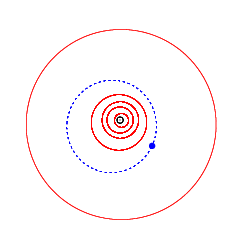9934 Caccioppoli
|
| |||||||||||||
| Discovery | |||||||||||||
|---|---|---|---|---|---|---|---|---|---|---|---|---|---|
| Discovered by | Edward L. G. Bowell | ||||||||||||
| Discovery date | 20 October 1985 | ||||||||||||
| Designations | |||||||||||||
| MPC designation | 9934 Caccioppoli | ||||||||||||
Named after | Renato Caccioppoli | ||||||||||||
| 1985 UC, 1981 SK7, 1989 TG14 | |||||||||||||
| Orbital characteristics[1] | |||||||||||||
| Epoch 13 January 2016 (JD 2457400.5) | |||||||||||||
| Uncertainty parameter 0 | |||||||||||||
| Observation arc | 11117 days (30.44 yr) | ||||||||||||
| Aphelion | 3.1766383 AU (475.21833 Gm) | ||||||||||||
| Perihelion | 1.980357 AU (296.2572 Gm) | ||||||||||||
| 2.5784975 AU (385.73774 Gm) | |||||||||||||
| Eccentricity | 0.2319726 | ||||||||||||
| 4.14 yr (1512.3 d) | |||||||||||||
| 160.64513° | |||||||||||||
| 0° 14m 16.952s / day | |||||||||||||
| Inclination | 16.62377° | ||||||||||||
| 11.24852° | |||||||||||||
| 294.50647° | |||||||||||||
| Earth MOID | 1.0276 AU (153.73 Gm) | ||||||||||||
| Jupiter MOID | 2.34953 AU (351.485 Gm) | ||||||||||||
| Jupiter Tisserand parameter | 3.330 | ||||||||||||
| Physical characteristics | |||||||||||||
| Dimensions | ~19.5 km[2] | ||||||||||||
| ~0.01 | |||||||||||||
| |||||||||||||
| C-type asteroid[3] | |||||||||||||
| 13.7 | |||||||||||||
|
| |||||||||||||
9934 Caccioppoli is a C-type main belt asteroid of the solar system. It orbits the Sun once every 4.14 years.[1]
Discovered on October 20, 1985 by Ted Bowell it was given the provisional designation "1985 UC". Later, it was renamed "Caccioppoli" in honour of Francis Caccioppoli, the director of the Naval Institute in Procida, and Renato Caccioppoli, an Italian mathematician, at the suggestion of Ettore Perozzi.[4]
References
- 1 2 "9934 Caccioppoli (1985 UC)". JPl Small-Body Database Browser. NASA/JPL. Retrieved 13 April 2016.
- ↑ Tedesco E.F.; Noah P.V.; Noah M.; Price S.D. "The supplemental IRAS minor planet survey (SIMPS)".
- ↑ Gianluca Masi; Sergio Foglia & Richard P. Binzel. "Search for Unusual Spectroscopic Candidates Among 40313 minor planets from the 3rd Release of the Sloan Digital Sky Survey Moving Object Catalog".
- ↑ MPC 42670 Minor Planet Center
External links
- What's in a name? Asteroid 9934 CACCIOPPOLI by Ettore Perozzi
- 9934 Caccioppoli at the JPL Small-Body Database

This article is issued from Wikipedia - version of the 9/10/2016. The text is available under the Creative Commons Attribution/Share Alike but additional terms may apply for the media files.
